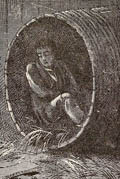
| J. B. Studley played his part [Buffalo Bill] to
perfection. The laudable desire he exhibits to avenge the
murder of his paternal ancestor and the coolness he displays
when encompassed by dangers and difficulties is superb.
Rounds of applause greeted him when, finding himself
surrounded by Indians, he slipped like a snake into a hollow
log; which log the redskins presently added as fuel to the
campfire; but the trapper soon found it grew uncomfortably
hot, so he threw his powder horn into the fire. There was a
grand explosion and the Indians went yelling skyward, while
the hero escaped unscathed. This, as might be expected, was warmly applauded by the "gods," but the highest pitch of excitement was reached in the third act when Jack McKandkess, a noted border ruffian, meets Buffalo Bill and a terrific hand-to-hand combat with Bowie knives three feet long ensues. The audience were spellbound, breathless, during this fierce encounter; but when it was brought to a conclusion by the death of the villain and the victory of Buffalo Bill, the burst of enthusiasm that followed would have rivaled the roar of Niagara. |
| Nixon's Amphitheatre was last night the scene of a most extraordinary character and one in which the audience bore quite as prominent a feature as did the occupants of the stage. The occasion was the first appearance of Ned Buntline's play with the blood-curdling and hair-raising title of The Scouts of the Prairie; or Red Deviltry As It Is, being a descriptive affair of life on the plains and in the mountains of the West, and in which the noted characters "Buffalo Bill" and "Texas Jack" in their own original selves were presented, as well as "Ned Buntline" the author of the play. Last night not less than 2,500 boys and young men crowded the amphitheatre to catch a glimpse of their heroes. Mlle. Morlacchi, the Italian danseuse, essayed the part of the Indian maiden Dove Eye with great success. |
| From Chicago the play toured eastward, playing to large and enthusiastic audiences in such places as Cincinnati, Buffalo (New York!), Boston and New York City. It wasn't long before what started as a play had evolved into a full-fledged spectacle -- Buffalo Bill's Wild West Show, with real "Indians" (by 1878), Annie Oakley (after 1884), extravagant horsemanship, buffalo roping and so on. As a very theatrical representation of "The West" it held audiences around the country captive until Bill's death in 1917. |
